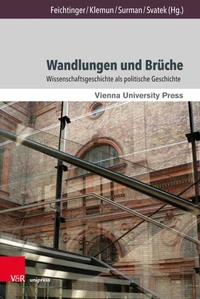Nikolaus Joseph Jacquin (1727–1817) – ein Naturforscher (er)findet sich
Par : , ,Formats :
Disponible dans votre compte client Decitre ou Furet du Nord dès validation de votre commande. Le format PDF est :
- Compatible avec une lecture sur My Vivlio (smartphone, tablette, ordinateur)
- Compatible avec une lecture sur liseuses Vivlio
- Pour les liseuses autres que Vivlio, vous devez utiliser le logiciel Adobe Digital Edition. Non compatible avec la lecture sur les liseuses Kindle, Remarkable et Sony
 , qui est-ce ?
, qui est-ce ?Notre partenaire de plateforme de lecture numérique où vous retrouverez l'ensemble de vos ebooks gratuitement
Pour en savoir plus sur nos ebooks, consultez notre aide en ligne ici
- Nombre de pages650
- FormatPDF
- ISBN978-3-8470-0710-4
- EAN9783847007104
- Date de parution15/05/2017
- Protection num.pas de protection
- Taille16 Mo
- Infos supplémentairespdf
- ÉditeurV&R Unipress
Résumé
Alles, was bisher über den Werdegang des Naturforschers Nikolaus Joseph Jacquin erzählt wurde, basiert weitgehend auf dessen Selbstdarstellungen. Dieses Buch zieht in neuer Weise unterschiedliche Quellen heran. Die beiden Autorinnen differenzieren den Aspekt von Jacquins Selbstformung und diskutieren, wie dieser von seinen Mäzenen Gerard van Swieten sowie Carl von Linné und von dem weltweiten Wissensaustausch mit Naturforschern abhängt.
Anhand der Wissensräume (botanische Gärten und chemisches Labor) werden die Wissenskonstituierung und Statusbildung analysiert. Die Studie ist dabei auf die Praxis der Naturgeschichte ausgerichtet. So legt sie etwa offen, dass Jacquin seine Karibikexpedition (1754-1759) in den Tropen mit einer Perücke bewältigte und gemeinsam mit Begleitern mehr als 104 Paar Schuhe verschliss. Everything that has so far been related about the career of the natural scientist Nikolaus Joseph Jacquin is largely based on his own self-portrayals.
The present book makes novel use of a range of different source materials. It distinguishes the aspect of Jacquin's self-fashioning, and discusses this in relation to his patrons Gerard van Swieten and Carl von Linné and their exchange of knowledge. Using knowledge spaces (botanical gardens and chemical laboratory), the constitution of knowledge and the creation of status are analysed. The facts that Jacquin undertook his Caribbean expedition (1754-1759) in the tropics wearing a wig and that, together with his attendants, he wore out more than 104 pairs of shoes, are details that are revealed by a study focussed on the practice of natural history.
Anhand der Wissensräume (botanische Gärten und chemisches Labor) werden die Wissenskonstituierung und Statusbildung analysiert. Die Studie ist dabei auf die Praxis der Naturgeschichte ausgerichtet. So legt sie etwa offen, dass Jacquin seine Karibikexpedition (1754-1759) in den Tropen mit einer Perücke bewältigte und gemeinsam mit Begleitern mehr als 104 Paar Schuhe verschliss. Everything that has so far been related about the career of the natural scientist Nikolaus Joseph Jacquin is largely based on his own self-portrayals.
The present book makes novel use of a range of different source materials. It distinguishes the aspect of Jacquin's self-fashioning, and discusses this in relation to his patrons Gerard van Swieten and Carl von Linné and their exchange of knowledge. Using knowledge spaces (botanical gardens and chemical laboratory), the constitution of knowledge and the creation of status are analysed. The facts that Jacquin undertook his Caribbean expedition (1754-1759) in the tropics wearing a wig and that, together with his attendants, he wore out more than 104 pairs of shoes, are details that are revealed by a study focussed on the practice of natural history.
Alles, was bisher über den Werdegang des Naturforschers Nikolaus Joseph Jacquin erzählt wurde, basiert weitgehend auf dessen Selbstdarstellungen. Dieses Buch zieht in neuer Weise unterschiedliche Quellen heran. Die beiden Autorinnen differenzieren den Aspekt von Jacquins Selbstformung und diskutieren, wie dieser von seinen Mäzenen Gerard van Swieten sowie Carl von Linné und von dem weltweiten Wissensaustausch mit Naturforschern abhängt.
Anhand der Wissensräume (botanische Gärten und chemisches Labor) werden die Wissenskonstituierung und Statusbildung analysiert. Die Studie ist dabei auf die Praxis der Naturgeschichte ausgerichtet. So legt sie etwa offen, dass Jacquin seine Karibikexpedition (1754-1759) in den Tropen mit einer Perücke bewältigte und gemeinsam mit Begleitern mehr als 104 Paar Schuhe verschliss. Everything that has so far been related about the career of the natural scientist Nikolaus Joseph Jacquin is largely based on his own self-portrayals.
The present book makes novel use of a range of different source materials. It distinguishes the aspect of Jacquin's self-fashioning, and discusses this in relation to his patrons Gerard van Swieten and Carl von Linné and their exchange of knowledge. Using knowledge spaces (botanical gardens and chemical laboratory), the constitution of knowledge and the creation of status are analysed. The facts that Jacquin undertook his Caribbean expedition (1754-1759) in the tropics wearing a wig and that, together with his attendants, he wore out more than 104 pairs of shoes, are details that are revealed by a study focussed on the practice of natural history.
Anhand der Wissensräume (botanische Gärten und chemisches Labor) werden die Wissenskonstituierung und Statusbildung analysiert. Die Studie ist dabei auf die Praxis der Naturgeschichte ausgerichtet. So legt sie etwa offen, dass Jacquin seine Karibikexpedition (1754-1759) in den Tropen mit einer Perücke bewältigte und gemeinsam mit Begleitern mehr als 104 Paar Schuhe verschliss. Everything that has so far been related about the career of the natural scientist Nikolaus Joseph Jacquin is largely based on his own self-portrayals.
The present book makes novel use of a range of different source materials. It distinguishes the aspect of Jacquin's self-fashioning, and discusses this in relation to his patrons Gerard van Swieten and Carl von Linné and their exchange of knowledge. Using knowledge spaces (botanical gardens and chemical laboratory), the constitution of knowledge and the creation of status are analysed. The facts that Jacquin undertook his Caribbean expedition (1754-1759) in the tropics wearing a wig and that, together with his attendants, he wore out more than 104 pairs of shoes, are details that are revealed by a study focussed on the practice of natural history.






